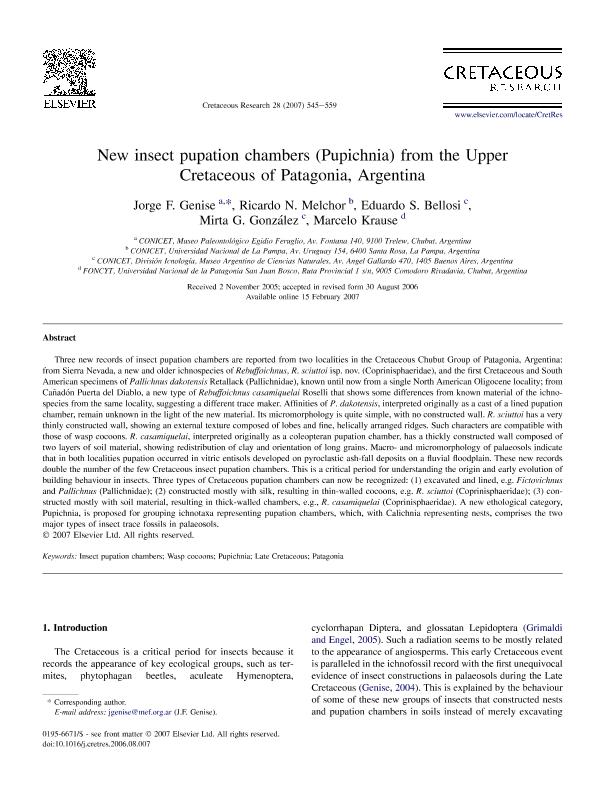Mostrar el registro sencillo del ítem
dc.contributor.author
Genise, Jorge Fernando

dc.contributor.author
Melchor, Ricardo Nestor

dc.contributor.author
Bellosi, Eduardo Sergio

dc.contributor.author
Gonzalez, Mirta Gladys

dc.contributor.author
Krause, Javier Marcelo

dc.date.available
2019-08-21T13:44:04Z
dc.date.issued
2007-06
dc.identifier.citation
Genise, Jorge Fernando; Melchor, Ricardo Nestor; Bellosi, Eduardo Sergio; Gonzalez, Mirta Gladys; Krause, Javier Marcelo; New insect pupation chambers (Pupichnia) from the Upper Cretaceous of Patagonia, Argentina; Elsevier; Cretaceous Research; 28; 3; 6-2007; 545-559
dc.identifier.issn
0195-6671
dc.identifier.uri
http://hdl.handle.net/11336/81909
dc.description.abstract
Three new records of insect pupation chambers are reported from two localities in the Cretaceous Chubut Group of Patagonia, Argentina: from Sierra Nevada, a new and older ichnospecies of Rebuffoichnus, R. sciuttoi isp. nov. (Coprinisphaeridae), and the first Cretaceous and South American specimens of Pallichnus dakotensis Retallack (Pallichnidae), known until now from a single North American Oligocene locality; from Cañadón Puerta del Diablo, a new type of Rebuffoichnus casamiquelai Roselli that shows some differences from known material of the ichnospecies from the same locality, suggesting a different trace maker. Affinities of P. dakotensis, interpreted originally as a cast of a lined pupation chamber, remain unknown in the light of the new material. Its micromorphology is quite simple, with no constructed wall. R. sciuttoi has a very thinly constructed wall, showing an external texture composed of lobes and fine, helically arranged ridges. Such characters are compatible with those of wasp cocoons. R. casamiquelai, interpreted originally as a coleopteran pupation chamber, has a thickly constructed wall composed of two layers of soil material, showing redistribution of clay and orientation of long grains. Macro- and micromorphology of palaeosols indicate that in both localities pupation occurred in vitric entisols developed on pyroclastic ash-fall deposits on a fluvial floodplain. These new records double the number of the few Cretaceous insect pupation chambers. This is a critical period for understanding the origin and early evolution of building behaviour in insects. Three types of Cretaceous pupation chambers can now be recognized: (1) excavated and lined, e.g. Fictovichnus and Pallichnus (Pallichnidae); (2) constructed mostly with silk, resulting in thin-walled cocoons, e.g. R. sciuttoi (Coprinisphaeridae); (3) constructed mostly with soil material, resulting in thick-walled chambers, e.g., R. casamiquelai (Coprinisphaeridae). A new ethological category, Pupichnia, is proposed for grouping ichnotaxa representing pupation chambers, which, with Calichnia representing nests, comprises the two major types of insect trace fossils in palaeosols.
dc.format
application/pdf
dc.language.iso
eng
dc.publisher
Elsevier

dc.rights
info:eu-repo/semantics/openAccess
dc.rights.uri
https://creativecommons.org/licenses/by-nc-nd/2.5/ar/
dc.subject
Insect Pupation Chambers
dc.subject
Late Cretaceous
dc.subject
Patagonia
dc.subject
Pupichnia
dc.subject
Wasp Cocoons
dc.subject.classification
Paleontología

dc.subject.classification
Ciencias de la Tierra y relacionadas con el Medio Ambiente

dc.subject.classification
CIENCIAS NATURALES Y EXACTAS

dc.title
New insect pupation chambers (Pupichnia) from the Upper Cretaceous of Patagonia, Argentina
dc.type
info:eu-repo/semantics/article
dc.type
info:ar-repo/semantics/artículo
dc.type
info:eu-repo/semantics/publishedVersion
dc.date.updated
2019-08-16T13:25:07Z
dc.journal.volume
28
dc.journal.number
3
dc.journal.pagination
545-559
dc.journal.pais
Estados Unidos

dc.description.fil
Fil: Genise, Jorge Fernando. Museo Paleontológico Egidio Feruglio; Argentina. Consejo Nacional de Investigaciones Científicas y Técnicas; Argentina
dc.description.fil
Fil: Melchor, Ricardo Nestor. Universidad Nacional de La Pampa; Argentina. Consejo Nacional de Investigaciones Científicas y Técnicas; Argentina
dc.description.fil
Fil: Bellosi, Eduardo Sergio. Consejo Nacional de Investigaciones Científicas y Técnicas. Oficina de Coordinación Administrativa Parque Centenario. Museo Argentino de Ciencias Naturales “Bernardino Rivadavia”; Argentina
dc.description.fil
Fil: Gonzalez, Mirta Gladys. Consejo Nacional de Investigaciones Científicas y Técnicas. Oficina de Coordinación Administrativa Parque Centenario. Museo Argentino de Ciencias Naturales “Bernardino Rivadavia”; Argentina
dc.description.fil
Fil: Krause, Javier Marcelo. Ministerio de Ciencia, Tecnología e Innovación Productiva. Agencia Nacional de Promoción Científica y Tecnológica. Fondo para la Investigación Científica y Tecnológica; Argentina. Universidad Nacional de la Patagonia "San Juan Bosco"; Argentina. Consejo Nacional de Investigaciones Científicas y Técnicas; Argentina
dc.journal.title
Cretaceous Research

dc.relation.alternativeid
info:eu-repo/semantics/altIdentifier/doi/https://doi.org/10.1016/j.cretres.2006.08.007
dc.relation.alternativeid
info:eu-repo/semantics/altIdentifier/url/https://www.sciencedirect.com/science/article/pii/S0195667107000110
Archivos asociados
